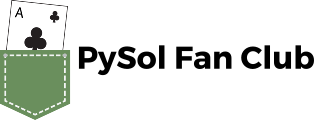
The easiest way to create a cardset would be to copy an existing cardset folder of the same type in your cardsets directory. All cardsets need a number of files to work.
The following optional files may also be added, but are only used under certain circumstances.
PySolFC solitaire cardset;$A;$FMT;$B;$C;$D,$E;$F;$G;$H <internal_name>;<cardset_name> X Y D XOFF YOFF SXOFF SYOFF back01.ext back01.ext;back02.ext;back03.ext
$A: The cardset version number that belongs to the number
of fields divided through ";" on the first line (e.g. .gif;1;78;8,1016 → $A=4)
(WARNING: For Mahjongg, $A must always be 6 or 7 and the $F
field must be included in the line; however, you can put 0 in $F if you wish, in that case.)
(NOTE: $D and $E are comma separated and count for one field)
$FMT: The format of the images used - .gif, .png, .jpg, .ppm, and .bmp are supported
$B: The type of the cardset (see types below)
$C: The number of cards in the cardset, generally 42, 48, 52, 68, 78, 96 or 120
$D: The Style of the cardset (this field can hold one or more comma separated values)
$E: The origin (country) of the cardset
$F: The Year the cardset was created (in the range 1000 to 2299)
$G: The subtype of the cardset. Usually 0 - for French type cardsets, a value of 1 is used if there are jokers. For Puzzle type cardsets, it is the number of pieces per row/column.
$H: Whether the cardset is a 3D Mahjongg cardset - 1 if it is, 0 if it isn't. For cardsets with a version less than 7, version 6 cardsets treat this value as 1, and older version cardsets treat it as 0.
<internal_name>: A name for PySolFC to identify your
cardset (without spaces)
(TIP: You could add a number prefix (e.g. 123-cardset-name) )
<cardset_name>: Your cardset name as it should appear
in the cardset manager. Note that a cardset name of more than 30 characters
will be truncated.
back01.ext: The name of the default back image (where ext means the file extension e.g: png or gif.)
back01.ext;back02.ext;back03.ext;…`: The name of the other
back images, including the default one.
NOTE: This tutorial may be incomplete. It is given as is, without any warranty, to help players customize their own cardsets. You are welcome to send any suggestions to: the Author’s E-mail, PySol FC’s GitHub issue tracker or PySol FC’s Sourceforge issue tracker.
NOTE 2: You should also place a file called COPYRIGHT in the same directory as config.txt, containing the text
that can be accessed via Info/Settings.
This tutorial was created under the terms of the GNU General Public License version 3 or later. You can redistribute it as is and/or modify it.
Shlomi Fish, hereby puts his modifications to this document under CC0/Public Domain/MIT License/GPL terms
Credits go to: